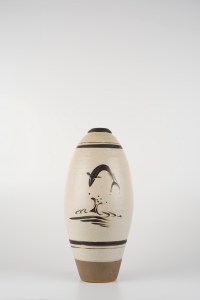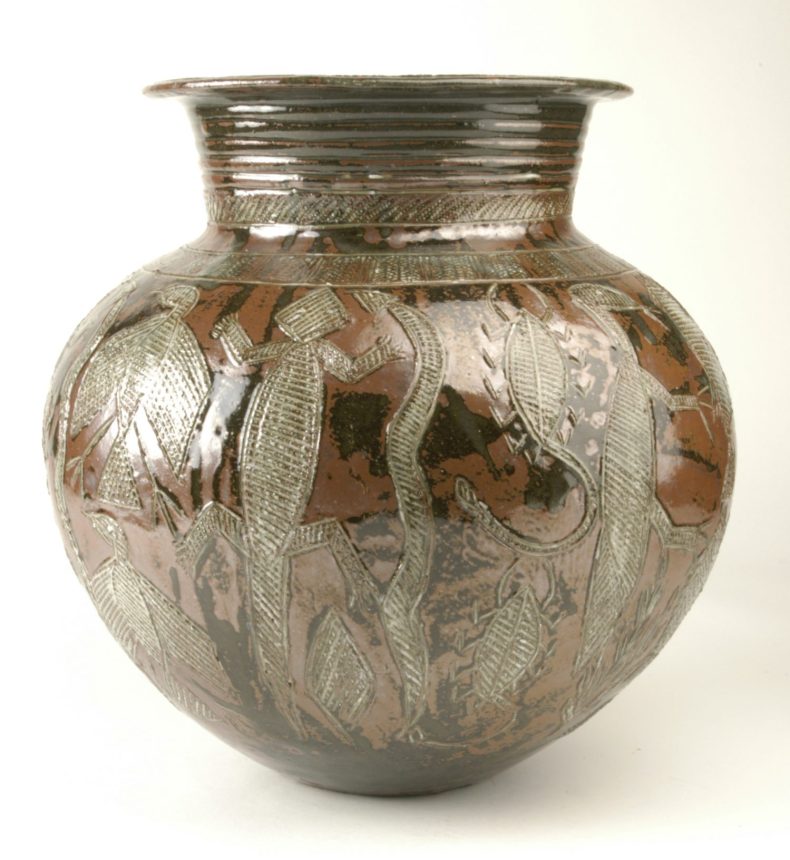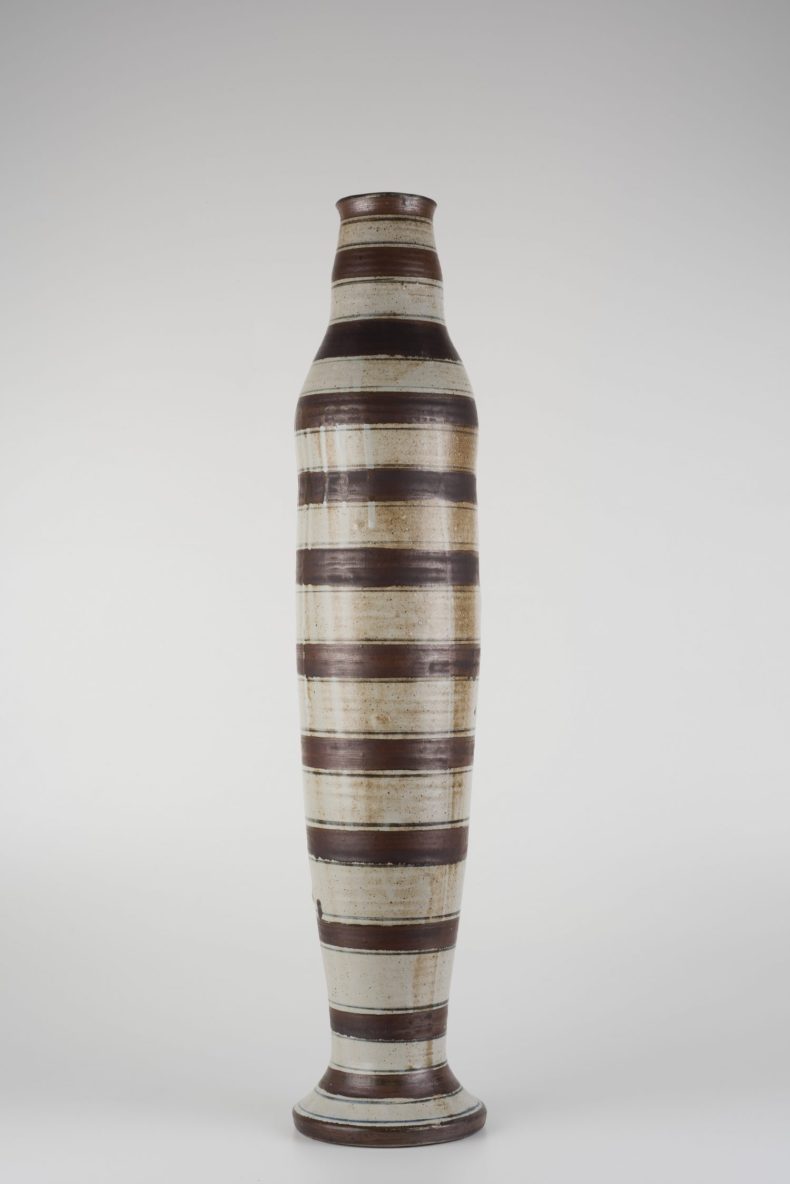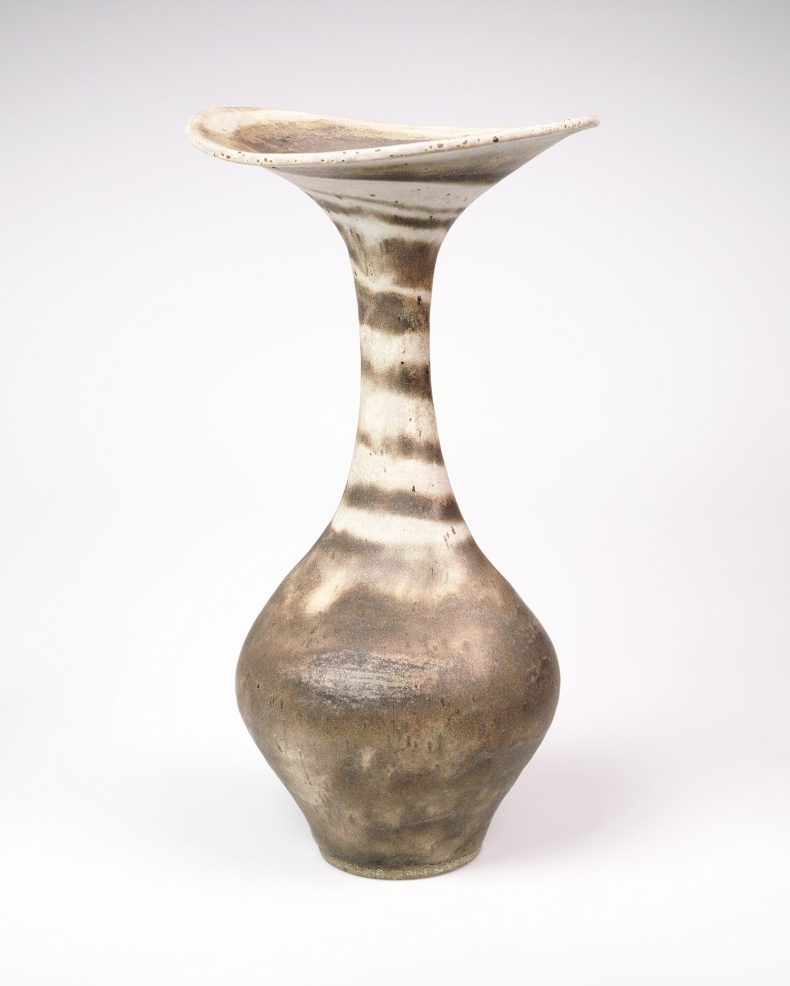This autumn the Yale Center For British Art, New Haven, home to the largest and most comprehensive collection of British art outside the United Kingdom, is mounting its first ever exhibition of ceramics. ‘“Things of Beauty Growing”: British Studio Pottery’ (14 September–3 December) is also the first exploration ever to take place in the United States of the significance of handcrafted ceramics to British modernism, and their enduring vitality in contemporary British visual culture. The neglect is explicable: the Yale Center owns no ceramics and the largest collections of British studio pottery in America are privately owned and rarely exhibited. But this exhibition, jointly curated by craft specialists Glenn Adamson, Simon Olding, and Martina Droth, also promises to be a revelation for British audiences when it reaches the Fitzwilliam Museum in Cambridge next year. For the show makes a claim for the coherence and cultural significance of an artistic genre that is not just a medium (clay) or a form (the vessel), but also a practice, of studio pottery. While rooted in ancient craft traditions, in Britain for more than a hundred years studio pottery has been in active and creative dialogue with sculpture, painting, literature, music, and architecture – and even installation and performance.
‘Ceramics, today, have never been so in vogue in the art world,’ comments Adamson. Last October, for instance, visitors to the Gagosian stand at Frieze London were met by a display of 10 vitrines by the British potter and author, Edmund de Waal, each one an elegy to a person or place important to the artist, and composed of porcelain vessels alongside fragments of graphite, silver and alabaster. De Waal’s works, with their wide range of reference – from Song dynasty pots to the writing of Walter Benjamin, from the art of Kazimir Malevich to the poetry of Paul Celan or the music of John Cage – have no sense of cultural inferiority. This September, ceramic artist Clare Twomey will be the launch artist for the second year of Tate Exchange, recreating a ceramics factory inside Tate Modern with the aim of engaging audiences in discussions about materials, knowledge, skill, and value, even as they make a china cup. Tate St Ives, meanwhile, celebrated the first phase of its reopening in March this year with an exhibition focusing on the ceramics studio in Britain and America, from Bernard Leach’s famous St Ives studio, founded in the 1920s, through to the present day (until 3 September). As Adamson puts it, ‘The medium has finally achieved unproblematic status.’
It has not always been thus. In Britain for many years pots – as they were disparagingly called by some, and honorifically titled by others – were embroiled in fraught debates: about art versus craft, and handwork versus industrial manufacture. Orthodoxies were fiercely protected. For the general public, this obscured the extent to which, all along, pots had played across these boundaries, becoming powerful vehicles for meaning through their encounters with so many contexts and points of reference: the domestic sphere and the gallery space; the industrial factory and the rural workshop; the exotic and the local; the ancient and the modern; the serene and the dynamic; the haptic; the allusive and the purely formal. The distinct idioms of British studio pottery emerged in dialogue with the main streams of modernism and the contemporary avant garde, without losing sight of the special symbolic status of the ceramic vessel.
The potter and art historian Julian Stair, some of whose monumental stoneware sarcophagi will feature at the YCBA, ascribes the genre’s contemporary appeal to the fact that ‘It is a multivalent art form, immersed in a social context, and engaging both the body and the mind.’ All the same, Adamson is aware that, however widespread the contemporary interest in ceramics, this exhibition’s determined focus on vessel forms, and on pots rather than the people who made them, will, in some ways, go against the tide. He and his co-curators, he says, ‘felt strongly that there was a philosophy embedded in these pots, to do with being centred, to do with the idea that a pot can anchor your perspective’, which is distinctive to the British studio pottery tradition and which would be lost to view in a wider survey of modern ceramics.

Leaping Salmon (1931), Bernard Leach. York Art Gallery; © The Estate of Bernard Leach
How this tradition emerged and evolved in Britain in the 20th century is the story of this exhibition. This is a far from local tale, however. Tradition has it that the British studio pottery movement was founded by Bernard Leach, who was born in Hong Kong in 1887, and who discovered his vocation as a potter during a lengthy second period of residence in the far East (principally Japan) between 1908 and 1920, when he returned to England to set up his pottery. In fact, the seeds had already been sown. In the 1870s, the designer Christopher Dresser had visited Japan, returning laden with objects, including ceramics; his near-contemporary, the artist-potter William de Morgan, absorbed Spanish, Italian and Middle Eastern influences into his work. In 1910, the Burlington Fine Arts Club put on an exhibition of early Chinese pottery and porcelain, introducing many people to what one early advocate described as ‘the chaste richness of Tang and Sung and Ming’. As Stair has argued, this was a trigger for Roger Fry to found the Omega Workshops in 1913, the studios and showrooms for which he himself produced pottery – seeing it, through the lens of the French Post-Impressionist art that he championed, as a quintessentially abstract art.
In 1914, the Burlington Fine Arts Club mounted an exhibition of early English earthenware, once dismissed, says Stair, ‘as crude and elementary’, but now hailed by many artists and critics as an authentic British riposte to decadent industrial ceramics. At the same time, the critic Clive Bell was developing his aesthetic philosophy of ‘significant form’, into which pots, apparently freed from content and appealing directly to our senses and emotions, aptly fitted. The ingredients were in place for a revolution in taste.

Water pot (c. 1956), Ladi Kwali. School of Art Gallery and Museum, Aberyswyth University
All the same, Leach was central to the emerging international outlook of studio pottery in Britain. Some of his fine personal collection of Korean and Chinese pots from the Song, Tang, and Yi dynasties, which set, as he wrote, ‘the noblest standard the world has known’, will be on display in this exhibition. Later on, Michael Cardew would enrich the tradition through his work in West Africa, introducing the virtuoso Nigerian potter Ladi Kwali to Britain and America; émigrés from central Europe, among them Lucie Rie and Hans Coper, brought sensibilities schooled in European modernism to bear on their potting. Adamson is clear: ‘The British studio ceramic tradition is forged by people who are cosmopolitan and syncretic in their approach. It is the opposite of nationalist.’
In keeping with this spirit, the 80 monumental red and gold porcelain vases of Clare Twomey’s Made in China (2010) will be displayed throughout the YCBA during the exhibition. Of these, 79 were made and decorated in the Chinese ceramic centre of Jingdezhen, while one was transported from China to be painstakingly hand-gilded at Royal Crown Derby in England, a process that cost as much as all the other pots combined. Twomey does not make her own pots, but hand-making as an idea, even in the context of ceramic factories, is part of the meaning of her work. Halima Cassell, meanwhile, who does carve her pots by hand, has created an installation, Virtues of Unity (2017), which brings together pots made from different clays collected by the artist from sites of ceramic production around the world, her patterns inspired by geometry and Islamic design.

The Bather (1930), William Staite Murray. York Art Gallery; courtesy the Estate of William Staite Murray and York Museum Trust
Alongside the dialogue with global traditions runs the conversation between ceramics and contemporary art. William Staite Murray, represented in this exhibition by several of his powerfully sculptural, anthropomorphic pots, began his life as a potter in 1915 in the pottery studio of the Vorticist painter Cuthbert Hamilton. As Stair outlines in an essay in the book accompanying the Tate St Ives exhibition, in 1919 Staite Murray joined the Arts League of Service alongside Edward Wadsworth and Paul Nash, taking part in group exhibitions with painters such as Cedric Morris and the sculptor Frank Dobson. Then, in 1924, Herbert Read and Bernard Rackham, then curators in the ceramics department of the Victoria and Albert Museum, published their seminal book, English Pottery. It was here that Read, with his interests in modernist poetry and art, pronounced that pottery forms, free from figurative associations, were ‘plastic art in its most abstract form’. In the same year, Rackham, reviewing Staite Murray’s first solo exhibition at Paterson’s Gallery in Old Bond Street, claimed that ‘Pottery can indeed be plastic sculpture in a purely abstract form.’
From the early 1920s, Staite Murray, and another pioneer potter, Reginald Wells, showed alongside artists such as Paul Nash and Jacob Epstein, and in 1926 Staite Murray was invited to teach pottery at the Royal College of Art, where he influenced artist-potters including Henry Hammond and the more radical Sam Haile. Although Song dynasty pots were his point of origin, and his own Buddhist faith an important inspiration, Staite Murray increasingly saw his work within the context of the contemporary avant garde, exhibiting with his contemporaries Henry Moore, Barbara Hepworth, Christopher Wood, Winifred and Ben Nicholson, and in 1927, joining the Seven and Five Society of Artists. As the catalogue to this exhibition suggests, Vortex, a bowl from the late 1920s, gestures simultaneously to avant-garde painting while drawing attention, through the black horizontal streaks in its interior, to the throwing action that brought the pot into being. A kinship of sensibility, expressed through form, texture and even the grouping of objects, is clearly identifiable between, for instance, Staite Murray’s pots from this period, Ben Nicholson’s reliefs, and Hepworth’s sculpture.
Staite Murray’s ideas about ceramics had been deeply enriched by his encounters with Shōji Hamada, Bernard Leach’s great friend and colleague at St Ives. Staite Murray’s work was anathema to Leach, however. It represented a challenge to the ideal he was articulating, in response to the ideas of the Japanese philosopher and founder of the Mingei (folk craft) movement, Sōetsu Yanagi, of the unknown craftsman, throwing humble, batch-produced wares for ordinary people. In 1927, in a pamphlet entitled A Potter’s Outlook, Leach launched an attack on ‘artist potters’, ‘working by hand to please ourselves as artists first and therefore producing only limited and expensive pieces’. The fact that these could appeal only to ‘collectors, cranks, or “arty” people,’ rather than to ordinary men or women, nullified them in his eyes: ‘they have not had the breath of reality in them: it has been a game.’
As de Waal points out in his 1998 book on Bernard Leach, the irony of this position was that Leach himself, as he recognised, was just such an artist-potter. Moreover, the reality of his own pottery business was that it was only through the support of patrons and the business acumen of his son David that it survived at all. Nonetheless, this diatribe contributed to a change in public attitudes towards pottery, certainly from the mid 1930s onwards, driving a rift between art and craft that, as Stair says, ‘ceramics has struggled to overcome ever since’. The shift was noticeable in the writings of Charles Marriott, a critic for The Times, who, from being Staite Murray’s most ardent champion, wrote in 1932 of his exhibition at the Lefevre Gallery that ‘in his enthusiasm for form and colour in the abstract he has lately been in danger of forgetting that a pot is after all a pot’. Travelling in Zimbabwe in 1939, Staite Murray found himself stranded by the outbreak of war. He never potted again.
Leach, meanwhile published his classic text, A Potter’s Book, in 1940, inspiring generations of rural potters and indeed ordinary readers with his vision of the nobility of the anonymous domestic pot, cheap enough to drop. This exhibition softens the ferocity of Leach’s didacticism with evidence of the extraordinarily beautiful, individual pots created under his charismatic influence. Olding is proud of the prominence the show gives to the exquisitely poised pots of Katharine Pleydell-Bouverie and Norah Braden, early pupils of Leach, which resulted from much focused experiment with glazes. The expressive slipware chargers of Leach’s first pupil, Michael Cardew, inspired by 17th-century English models but animated by a painterly use of runny slipware, reveal how even the most tenacious dedication to the principles of traditional pottery is compatible with originality. As Tanya Harrod, Cardew’s biographer, has said, he ‘was not simply reviving English slipware. Instead he created a personal but transcendent visual language’. Pieces by Richard Batterham, hand-thrown from clay he prepares himself, and fired, with their glossy greenish glazes, in kilns fed by trees that he grows, also testify to the subtle, sophisticated beauty this tradition still fosters.

Bottle (1970s), Lucie Rie Crafts Study Centre, Farnham
As this exhibition reveals, however, countervailing spirits were at at work during the period of Leach’s dominance – and not least Lucie Rie and Hans Coper, who in the late 1930s had found refuge in London from Vienna and Nazi Germany respectively. Rie had been trained in the Kunstgewerbeschule, a school of arts and crafts associated with the Wiener Werkstätte, which set a high value on harmonious design in a modernist idiom. Hans Coper’s primary artistic influences were the work of Constantin Brancusi, marble Cycladic figures, and Egyptian pre-dynastic pottery. Neither cared a fig for rural authenticity. Although seeming to represent rival schools, however, Lucie Rie and Bernard Leach maintained a close friendship from their first meeting. This is dramatised in the exhibition by a section devoted to the ‘moon jar’ form. In 1943, Bernard Leach entrusted a beautiful Korean moon jar to Lucie Rie, which she kept until her death in 1995. It is one of only 20 examples of its type surviving from the Joseon dynasty, and an archetype, for Leach, of the folk craft pot. Rie bequeathed the pot to Leach’s widow, Janet Leach, herself a potter, who placed it with a small white sculpture by Barbara Hepworth and a painting by Kate Nicholson, daughter of Ben and Winifred. Although the moon jar is now in the British Museum and cannot travel to New Haven, it is represented through an array of responses to it that have been commissioned for the exhibition; from Adam Buick’s serene contemporary moon jars to Nao Matsunaga’s coiled and slabbed sculptures, these honour the potency of the ancient moon jar as both object and symbol.

Moon jar (18th century), Korean, Joseon Dynasty. Photo: © Trustees of the British Museum
Since the 1970s, counter to the prevailing image of brown rustic pots inspired by Leach, British studio pottery has in fact been alive with contradiction and variety. There are the musically inspired pots of Elizabeth Fritsch, with their metaphysical decoration; Gordon Baldwin’s modernist evocations of landscape; Ewen Henderson’s fractured, quasi-geological vessels; and Alison Britton’s postmodern pots, with their exuberant metaphorical play on the idea of jug, charger, and vase. Other ceramic artists, among them Jennifer Lee, Rupert Spira, Magdalene Odundo and Edmund de Waal, have continued to explore the pregnant stillness of the simple pot. The ceramic vessel, as Wallace Stevens wrote of his grey, bare jar on a hill in Tennessee, continues to ‘[take] dominion everywhere’.
From the July/August issue of Apollo. Preview and subscribe here.














![Masterpiece [Re]discovery 2022. Photo: Ben Fisher Photography, courtesy of Masterpiece London](http://zephr.apollo-magazine.com/wp-content/uploads/2022/07/MPL2022_4263.jpg)
‘Like landscape, his objects seem to breathe’: Gordon Baldwin (1932–2025)